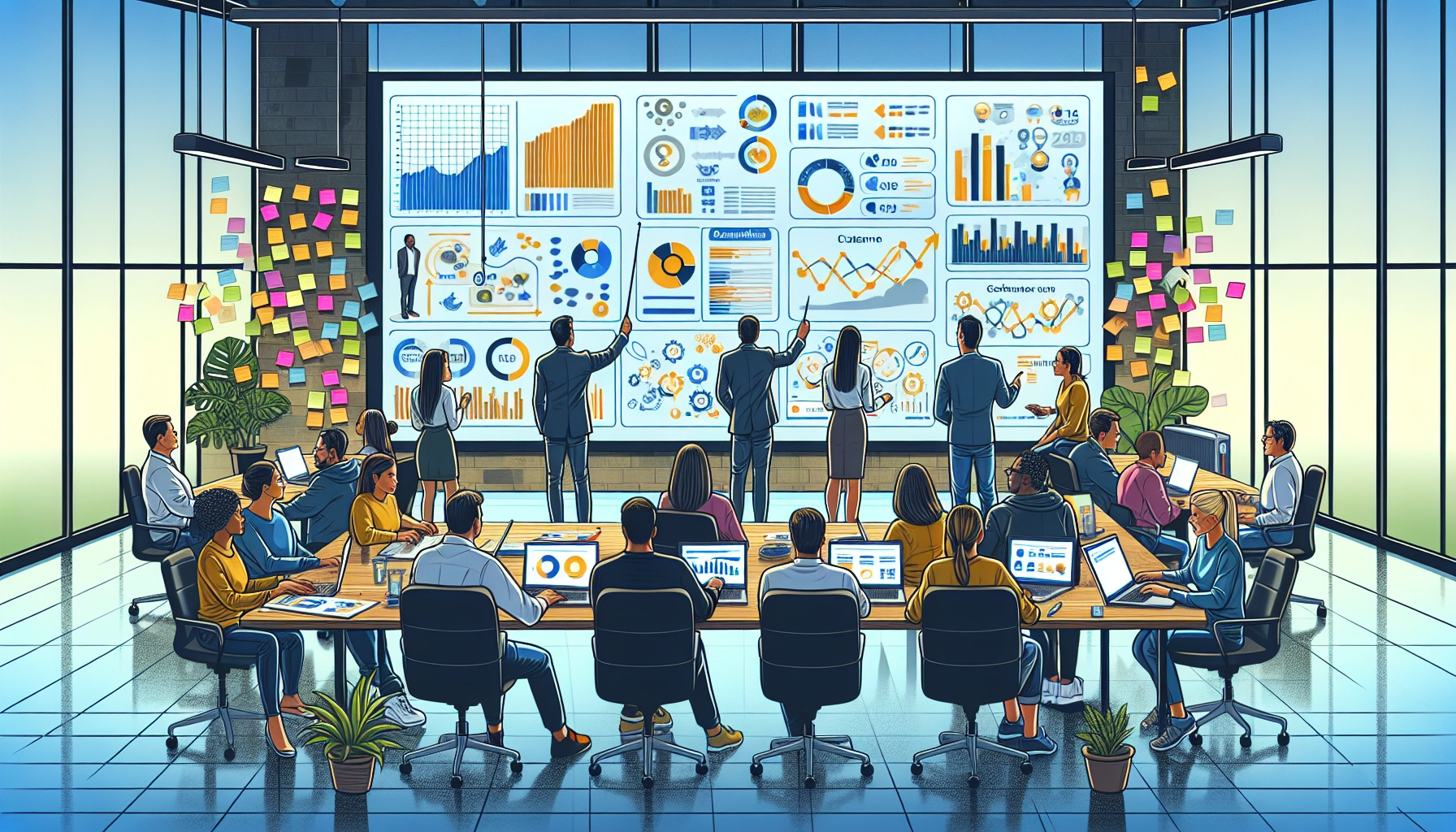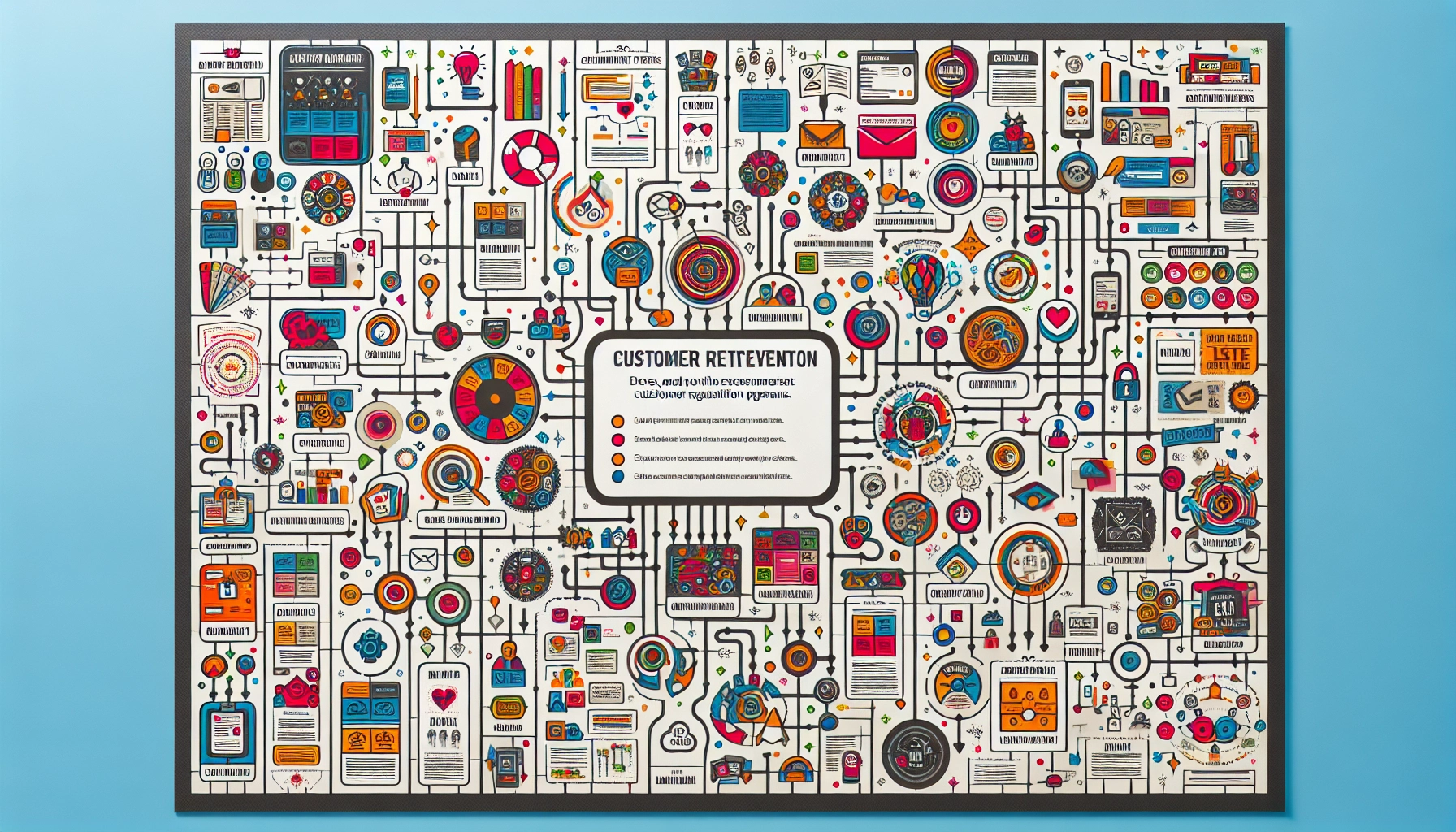Table of Contents[Hide][Show]
Customer retention management ensures your existing customers stay happy and loyal. This article explores practical strategies and tools to help you achieve this goal.
Key Takeaways
Customer retention management focuses on maintaining and enhancing relationships with existing customers to reduce churn and foster long-term loyalty, requiring a strategic approach that adapts to evolving customer behaviors.
Key components of effective retention management include establishing customer feedback loops, utilizing customer experience management tools, and offering personalized experiences through technology to enhance customer satisfaction.
Prioritizing customer retention yields numerous benefits, including reduced costs compared to customer acquisition, increased customer lifetime value, and the creation of brand ambassadors who generate referrals, thereby providing a competitive advantage.
Understanding Customer Retention Management

Customer retention management is the process of keeping your existing customers engaged and happy to improve retention rates. Unlike customer acquisition, which focuses on acquiring new customers, a customer retention management program is about maintaining and growing relationships with existing customers. This is key to reducing customer churn and achieving long-term business success.
In B2C and B2B, customer retention management is about understanding and adapting to changing customer behavior and market dynamics. B2C is about broad customer-facing initiatives, while B2B is about one-to-one.
Definition and Importance of Customer Retention
Customer retention refers to the ability of a business to retain its existing customers over time. It is a crucial aspect of any business strategy, as it directly impacts revenue, customer satisfaction, and overall growth. Customer retention is essential because it costs significantly less to retain an existing customer than to acquire a new one. In fact, studies have shown that acquiring a new customer can be 5-25 times more expensive than retaining an existing one. Moreover, loyal customers are more likely to provide positive word-of-mouth, referrals, and repeat business, leading to increased revenue and growth.
Key Components of Effective Customer Retention Management
Customer retention is multifaceted. Here are the key bits:
Customer feedback loops: Collect, analyze, and act on customer feedback to improve and meet customer expectations.
Regular surveys: Surveys help you identify areas to improve and retain.
Act on feedback: Acting on feedback builds trust and shows customers you value their opinion.
By doing these three practices, you will retain more customers.
And customer experience management tools. These tools help you monitor customer interactions and feedback, enabling you to make data-driven decisions to retain customers. Analyze customer behavior to identify retention issues and make informed decisions. This process is also a keep part of an effective company reputation strategy.
Benefits of Prioritizing Retention
Retaining customers has many benefits. Financially, it’s 25 times more expensive to acquire new customers than to retain existing customers. Repeat customers generate steady revenue and tend to spend more over time, thereby increasing their lifetime value to your business. Improving the customer experience can also reduce common causes of customer churn.
Beyond the financial benefits, loyal customers serve as brand ambassadors, promoting your small business marketing efforts through word of mouth and referrals. This not only increases brand loyalty but also sets you apart in a crowded market. Recognizing and rewarding your top customers can solidify these benefits and give you a competitive edge, fostering long-term loyalty.
Measuring Customer Retention Rate

Your customer retention rate is key to measuring your retention strategies. The formula is simple: Customer retention rate = (E-N) / S x 100, where E is the number of customers at the end of the period, N is the number of new customers acquired during that period, and S is the number of customers at the start. Track this quarterly and you’ll see how your retention efforts are working and where to improve.
A high rate means your retention is working and customers are happy. A low rate means you have issues to fix to prevent customer churn. Tracking this regularly is key to a healthy customer base and business growth.
Tools for Tracking Retention Metrics
To track retention metrics, you need analytics software that can pull in data from multiple sources. Customer experience software like Qualtrics XM® gives you insights into customer interactions so you can track and measure retention metrics. These tools help you understand customer behavior and preferences, which is key to building a retention strategy.
Automated tools, such as chatbots and self-service portals, can also simplify customer service and retention. These tools provide a comprehensive view of customer interactions, enabling you to make data-driven decisions that improve retention.
Strategies to Improve Customer Retention

Customer retention is multifaceted. The key is to create personal experiences, proactive support, and trust and reliability. These will increase customer satisfaction and long-term loyalty.
Engagement strategies like product reviews, proactive communication, and referral programs will increase customer interaction and customer retention. Unique services, loyalty rewards, and regular discounts will be incentives to bring customers back.
A well-designed onboarding process can help new customers quickly understand the value of a product or service, reducing the likelihood of customer churn.
Continuous customer feedback is key to refining these and customer success experiences.
Onboarding and Engagement
Onboarding and engagement are critical components of customer retention. A well-designed onboarding process can help new customers quickly understand the value of a product or service, reducing the likelihood of churn. Engagement strategies, such as regular marketing and communication, personalized offers, and loyalty programs, can help build strong relationships with customers, increasing their loyalty and retention. Effective onboarding and engagement require a deep understanding of customer needs, preferences, and behaviors, which can be achieved through customer feedback, data analysis, and journey mapping.
Personalized Customer Experiences
Personalized customer experiences are a key to customer loyalty. When customers feel heard and understood, they will remain loyal. 80% of companies that use personalization see increased customer loyalty. Using AI and CRM systems allows you to deliver those personalized experiences and retain them.
Technology plays a big part in this. Salesforce Customer 360 and similar platforms give you a 360-degree view of customer data so you can deliver tailored experiences that retain. Customizing the onboarding experience and tailoring options to individual customer needs rather than using templated solutions will strengthen customer relationships even more.
Proactive Customer Support
Proactive support stops customer churn and increases customer satisfaction. Regular check-ins help you anticipate and solve customer problems early. AI tools can automate support, and you can solve customer queries faster and better.
Fast response to customer queries is linked to higher satisfaction, so proactive support is part of customer retention efforts. Solving problems before they escalate increases customer loyalty and retention.
Building Trust and Reliability
Trust and reliability are key to customer retention. Customers need to feel safe in their decisions, and reliability is the key to that. Consistency in delivering on promises builds trust with customers, and they will remain loyal.
Data is super helpful for this. Analyzing customer behavior patterns helps businesses build retention strategies that meet customer needs and wants. Trust is a significant factor in buying decisions, and 81% of customers consider it essential.
Implementing a Customer Retention Management System

A customer retention management system has to be customer-centric. Asking the right questions and getting the insights is key to building retention strategies. Linking customer data to revenue shows how vital those insights are to retention.
Tracking customer journeys and building relationships is key to preventing customer churn. Customer retention techniques vary by product lifecycle and business goals, so you have to tailor your approach accordingly.
Setting Clear Retention Goals
You need to define specific goals and metrics for retention. Key metrics to track are quarterly customer lifetime value and monthly engagement. Customer journey or buyer journey analytics is also essential for retention and strategy.
Defining goals allows you to measure retention and make data-driven improvements. This way, retention programs are aligned with business goals.
Aligning Teams with Retention Objectives
Cross-departmental alignment is key to a customer retention management system. Involving key personnel from various departments ensures that everyone is working towards the same retention goals. Clear communication on roles and responsibilities prevents retention issues.
Aligning teams to retention goals means strategy works and a joined-up approach to customer retention. This is key to a reasonable customer retention rate and a loyal customer base.
Proactive Issue Resolution and Convenience
Proactive issue resolution and convenience are essential for customer retention. Businesses that can quickly and efficiently resolve customer issues, often before they become major problems, can build trust and loyalty with their customers. Convenience is also a key factor, as customers expect easy and seamless interactions with businesses. This can be achieved through self-service options, mobile apps, and streamlined processes. By providing proactive issue resolution and convenience, companies can reduce customer frustration, increase satisfaction, and improve retention.
Empowering Customers
Empowering customers is a critical aspect of customer retention. Businesses that provide customers with the tools, resources, and support they need to succeed can build strong relationships and increase loyalty. This can be achieved through customer education programs, personalized recommendations, and flexible solutions. By empowering customers, businesses can increase customer satisfaction, reduce churn, and improve retention. Additionally, empowered customers are more likely to become brand advocates, providing positive word-of-mouth and referrals.
Examples of Successful Customer Retention Programs

Customer retention programs can boost customer satisfaction and loyalty. Companies like Coca-Cola, Amazon, and HubSpot have implemented cool retention strategies that create brand ambassadors who promote their products.
These programs usually involve creating good customer experiences and offering special perks. For example, Amazon Prime provides exclusive content and events, customer loyalty, and retention. HubSpot Academy engages customers through education, so they stay informed and involved.
Loyalty Programs
Loyalty programs are a proven way to retain customers. They reward customers for being loyal, as seen in programs like Starbucks Rewards and Amazon Prime. They incentivize repeat business by offering points that can be redeemed for rewards and engagement.
Recognizing your top customers is key, as they make up a big chunk of your business’s revenue and growth. By making your loyal customers feel valued and appreciated, you can increase your retention rates and long-term loyalty.
Community Building Initiatives
Having a community around a product gets customers active and loyal in the long term. Nike’s community initiatives use apps and partnerships to increase customer loyalty and engagement. These initiatives make customers feel part of something and more likely to stick with the brand.
By providing customers with opportunities to interact and engage with one another, customer engagement businesses can strengthen customer relationships and increase retention.
Enhancing Customer Satisfaction for Better Retention
Customer satisfaction is the key to retention. First impressions count, and a good onboarding is crucial for customer adoption and satisfaction. A good onboarding process should have workflows, reminders, and self-service resources to get new customers started.
Small things can become big problems if not fixed. Customers feel listened to, understood, and valued, which is key to satisfaction and long-term loyalty.
Gathering and Acting on Customer Feedback
Getting and acting on customer feedback is key to satisfaction and retention. In-app surveys and online feedback tools are great ways to get feedback. Seeking feedback proactively at different touchpoints helps you find issues and improve satisfaction.
Customer feedback is key to finding areas to improve, and ultimately, satisfaction and retention. By acting on feedback, you show customers you value their opinion and are committed to change.
Addressing Customer Pain Points
Customer pain points are key to reducing customer churn and overall happiness. Tracking customer feedback and user journeys in real time helps you spot these pain points before they become big problems. Understanding user behavior lets you catch problems early and fix them.
Retention software aggregates all the data from all the interactions so you can spot and fix issues. Signs a customer is at risk of churning are fewer purchases, less engagement, and lukewarm feedback.
Leveraging Technology to Boost Retention
Using advanced technology can supercharge your customer retention strategies. AI and real-time analytics help you understand customer behavior and preferences so you can tailor your engagement. These tools let you watch customer behavior closely so you can adjust retention strategies proactively.
Using tech gives you deeper insight into customer interactions so you can make data-driven decisions that improve retention. This means retention is aligned to customer needs and expectations, so you get higher satisfaction and loyalty.
Customer Experience Management Software
Customer experience management software is key to tracking and improving customer interactions to retain customers. Tools like Qualtrics XM® give you insights from every touchpoint so you can track retention and churn rates. Automated tools like chatbots and self-service portals simplify customer service and retention.
Using software like the Starbucks app can give you more customer data to use to create personalized experiences and retain more customers. Integrating these tools into your retention strategy will enhance customer interactions and loyalty.
AI and Real-Time Analytics
Real-time analytics and AI tools are a game-changer for customer retention. They allow you to see customer behavior and preferences in real time and make adjustments to your retention strategy on the fly. AI can analyze customer data in real-time, enabling you to predict and respond to customer needs more effectively.
Real-time data analysis with AI means you can engage with customers faster and tailor communication based on what they are doing right now. This means you can fix issues fast and keep customer satisfaction and retention high.
Summary
Optimizing customer retention management is vital for businesses aiming to succeed amid intense competition. Grasping the essential elements that contribute to successful retention, closely monitoring related metrics, and applying strategies with a track record of success can significantly boost both customer loyalty and contentment. Emphasizing retaining customers not only helps in reducing expenses but also increases their lifetime value while turning them into advocates for your brand.
By harnessing cutting-edge technology like software designed for managing customer experiences or analytics powered by artificial intelligence, companies can deepen their understanding through insights and take initiative in fostering stronger connections with customers. The proof lies in the efficacy of outstanding customer retention programs, which show just how impactful these methodologies are when done right. A robust commitment to keeping customers coming back is key to achieving ongoing growth for a business and cultivating an enthusiastic consumer base loyal to your brand.
Frequently Asked Questions
What is customer retention management?
Customer retention management involves implementing strategies to engage and satisfy existing customers, ultimately aimed at maintaining and improving retention rates. This approach emphasizes the importance of fostering lasting relationships with clients.
Why is customer retention necessary?
Retaining customers is essential because it not only enhances the customer lifetime value and ensures a steady cash flow due to its cost-effectiveness, but also fosters brand loyalty as these loyal customers often become advocates for your business, promoting it further.
How do you measure customer retention rate?
To measure customer retention rate, use the formula:
Customer Retention Rate = (E-N) / S x 100.
Where E is the number of customers at the end of a period, N is the number of new customers acquired during that period, and S is the number of customers at the start.
This calculation provides a clear percentage reflecting your business’s ability to retain customers over time.
What are some effective strategies to improve customer retention?
To enhance satisfaction and foster loyalty, creating personalized experiences for customers, providing proactive support, and building trust are potent tactics that can be employed to improve customer retention effectively.
How can technology help in boosting customer retention?
By deploying AI-driven analytics and customer experience management tools, companies can monitor interactions and gain insights into customer behavior. This empowers them to make data-driven choices that substantially improve their strategies for retaining customers.
 85 Powerful SEO Statistics for 2025
85 Powerful SEO Statistics for 2025